This is the fourth in a series of posts, each one about an island we’re visiting while on our grand tour of French Polynesia. (The first post was about Mo’orea, the second was about Rangiroa, and the third was about Fakarava.)
For this post, we had to put some miles between us and Tahiti. Back to class for a minute – Hiva Oa is one of six inhabited islands in the Marquesas Archipelago, which is in the northeast corner of French Polynesia. If we had continued on our sailing adventure to FP, this is where we would have made landfall, as it’s the closest island to the Galapagos where you can check in. (Coincidentally, the day after we arrived here, Oneiro did, too. They were about 22 days getting here from Galapagos, and from all accounts, they had a wonderful time making their dream trip. In that same amount of time, through the miracle of flight, we have already had a fantastic time exploring three other islands. Different strokes for different folks.) Hiva Oa is 870 miles from Tahiti – that’s about the distance from Indianapolis, Indiana to Satellite Beach, Florida (the two places I’ve lived the most in my life). The little island right next to Hiva Oa (Tahuata) is where the first Europeans (the Spanish) “discovered” the Polynesian islands, in 1595. Of course, they didn’t discover it – there had been people living here for centuries. They just came across it while looking for the Solomon Islands. Came ashore, and while here, did a Catholic Mass, erected some crosses, and “through a misunderstanding, massacred about 200 of the natives”. (Yep – not making that up. Sigh…)
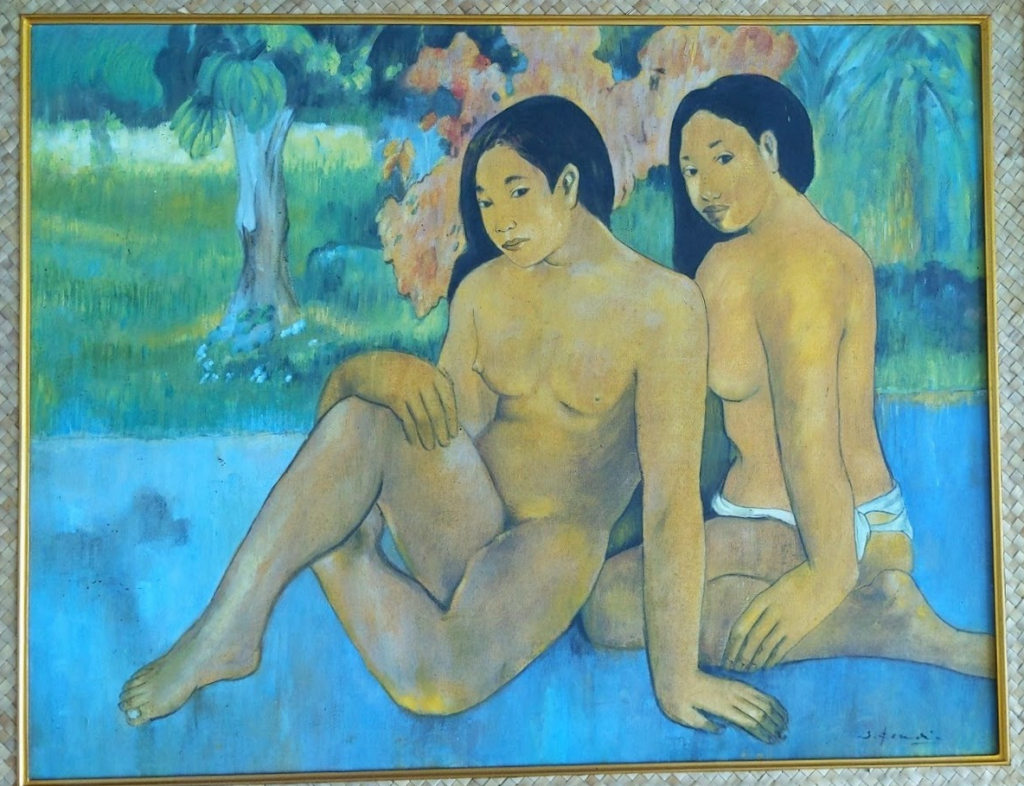
We had only four full days on Hiva Oa, so we tried to make the most of them. The day we arrived (Day Zero), we walked around the main village of Atuona, which is where the French painter Paul Gauguin spent the last year or so of his life. He died and is buried here – we visited the museum the day we arrived, and later visited his grave in the local cemetery. In 2015, a Gauguin painting sold for about $300 million, so it’s no surprise that the museum here doesn’t have any originals. (You could buy most of the homes on the whole island for that, I’m guessing.) But they have some nice copies of many of his works, especially the works from his time in French Polynesia, which included a stretch in Tahiti before Hiva Oa.
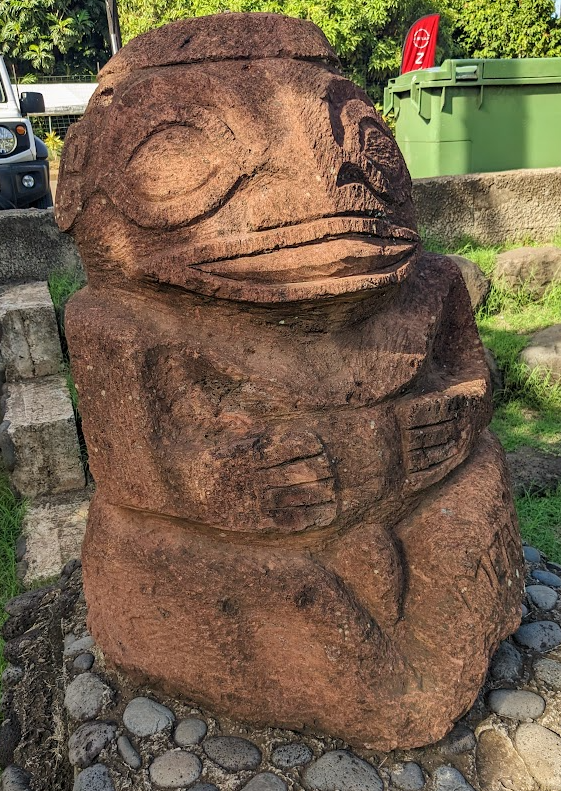
We also visited the local artist’s co-op, and the community’s outdoor gathering and performance venue, which is decorated with large stone tikis that have been given as gifts to the island from surrounding islands on various special occasions. But we were just priming the pump for the next two days, when we would get to experience some real local culture.
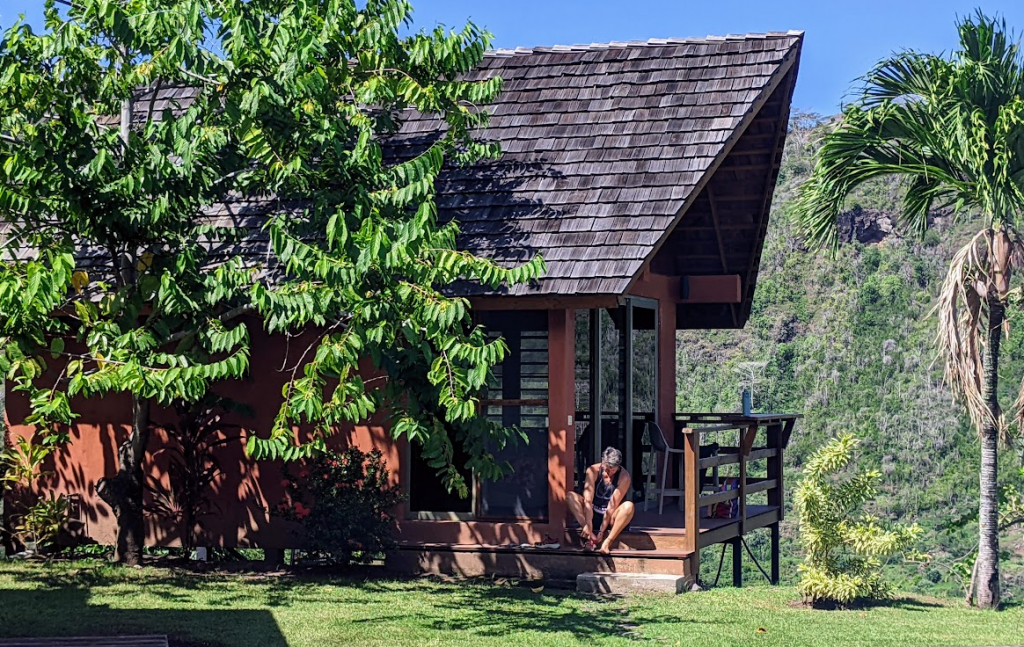
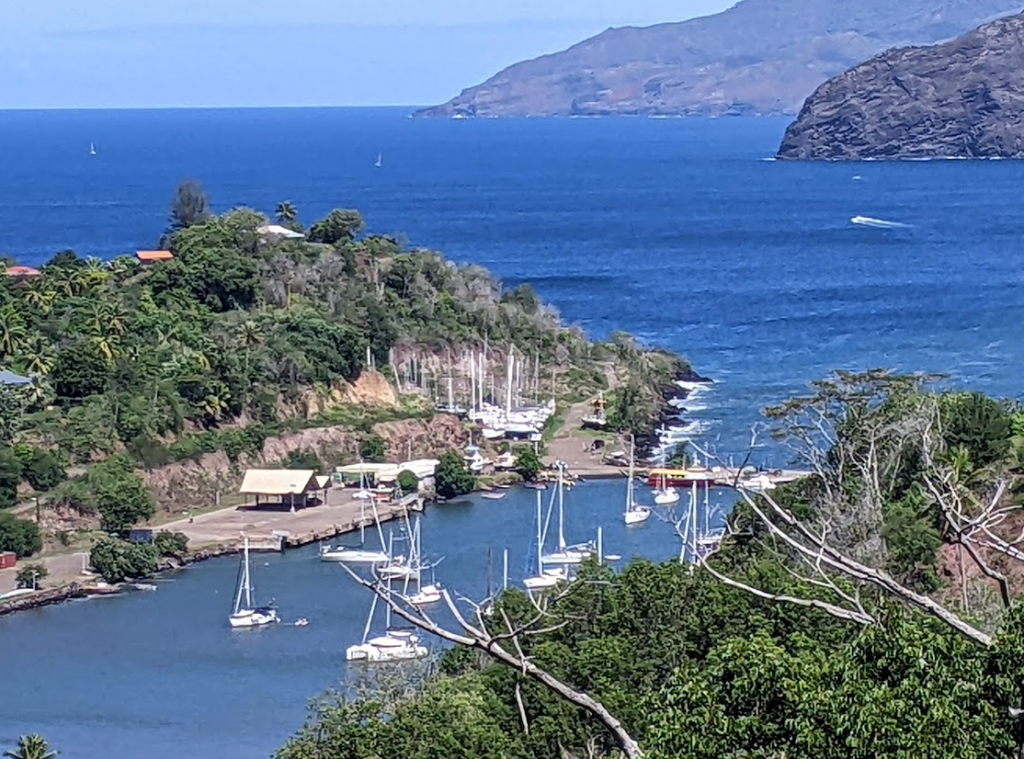
Day One began with by far the best breakfast so far on this trip. We’re staying at a guest house called Villa Enata (“enata” is the word Marquesans use to refer to themselves), which includes breakfast and dinner. Breakfast every day: baguettes, fresh baked multi-grain bread, real butter, soft cheese, some kind of deli meat to eat with the cheese and bread, and fresh grapefruit, papaya, mango, star fruit, and banana, all of which comes from trees in their yard! Two or three kinds of homemade jam, local honey, and coffee. Finally – real, good, strong, flavorful, brewed, black coffee, in a pot that you can pour into your own cup and luxuriate in, as much as you want! (We have not encountered this on the entire trip, since leaving home March 31 – could you tell?) Dinner has been excellent as well, most nights featuring fresh-caught tuna, which is very common everywhere we’ve been in FP. Sashimi, tartare, carpaccio, and two other raw preparations that are to die for: poisson cru au lait de coco (raw fish with coconut milk) and poisson cru de chinoise (raw fish Chinese style). We’ll be making some of this stuff back at Southermost Smartini, you can bet!
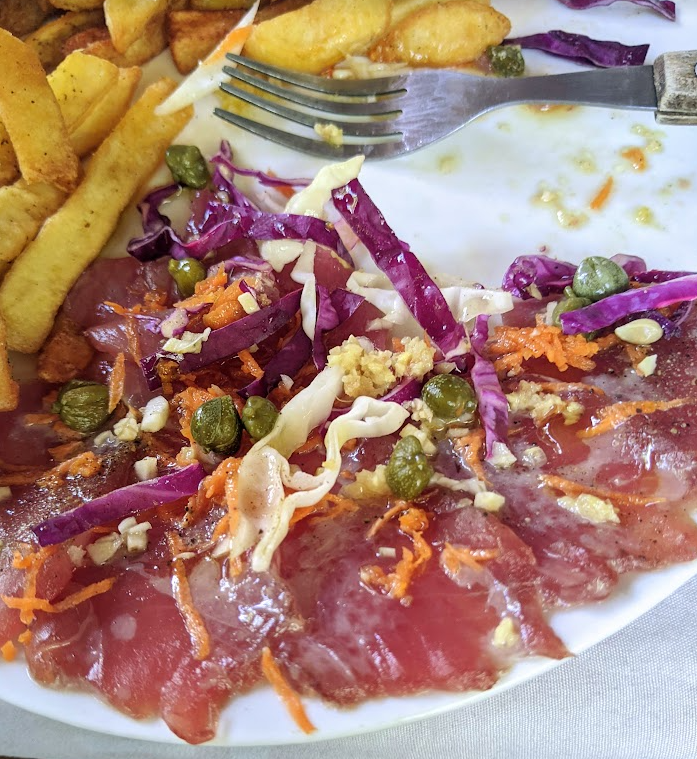
But I digress. I was going to tell you about Day One. After breakfast, we were picked up by a local gentleman who was introduced to us a “Bly”. He spoke excellent English, and we hopped in the back of his truck, then picked up another couple, and headed for the dock, where a third couple joined us. We all boarded a boat (mainly used for fishing, but today for carrying passengers) and headed for Tahuata (see above). Just like the first Spaniards, then the first French almost 200 years later, we made landfall at the small village of Hapatoni. As we walked along the beach in the village, Bly stopped about a half dozen times and told us how to use the fruit or nut or leaf or root of the tree or bush we were walking by, to cure insomnia, a stuffy head, ciguatera, and all manner of other maladies, as taught to him by his grandmother. He explained everything in a perfect mix of French (the other two couples were French) and English, with plenty of Marquesan thrown in for local flavor.
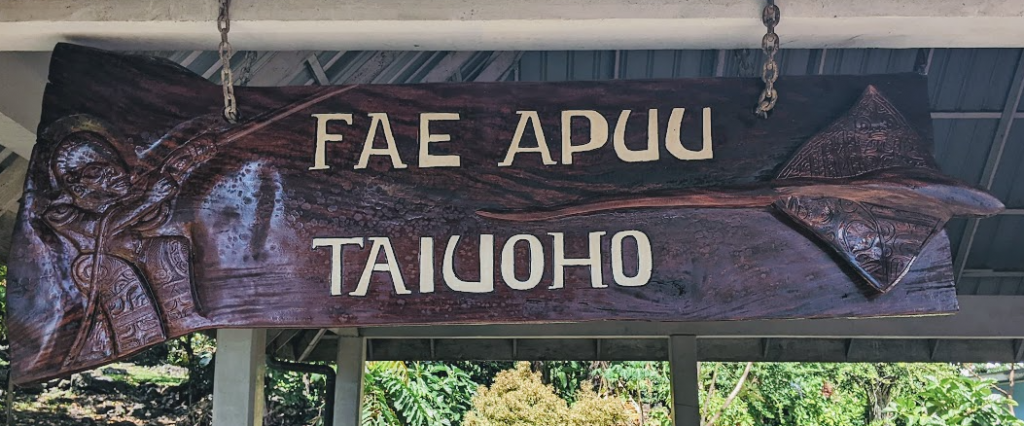
Our first stop was Fae Apuu Taiuoho, which you probably know means “arts and crafts”. (No, I don’t know what it really means, but it was on the sign of the place where we stopped, and inside were the amazing works of the local artists. See the picture.) The people on Tahuata live mostly off the land and sea, catching fish and raising goats, cattle, pigs and chickens, and lots of fruits and vegetables. But to buy things they can’t get locally (flour, sugar, Milky Way bars, etc.), they historically would process coconuts into something called copra and sell it in Tahiti. (Copra is the intermediate step between coconuts on the tree and coconut oil.) But several decades ago, they began to expand the practice of carving on the island, and now their “cash crop” is no longer copra, but carvings. And they are amazing. We bought some smaller ones to bring home, and wished that we could have bought some of the bigger ones, but getting them home would have been a problem. There were a few swords / spears (not really sure what to call them) made from bone and wood and the bill of a marlin, with a wrapping of twine made from coconut husk (all in the same piece) that were absolutely spectacular. Out of respect (or just stupidity), we didn’t take pictures of things – probably should have, huh? Below is a photo I found online of one of them.
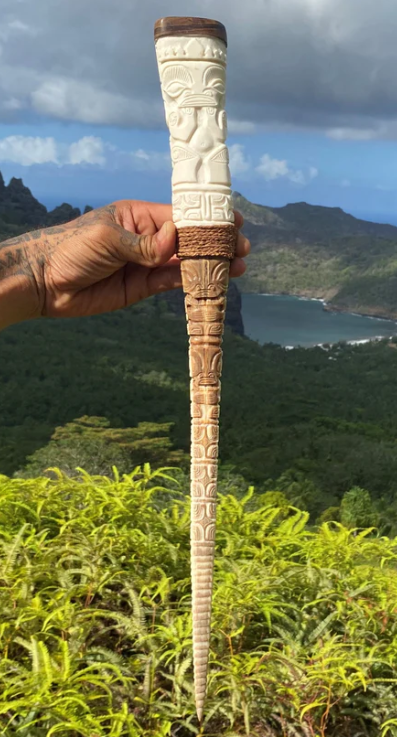
(While looking up information about Tahuata, I found a really well-written blog post of a sailing couple, about their visit to Tahuata in 2015. Click here to read it if you’re interested.)
One of the gentlemen who did the carvings was a living exhibit of another art form that is attributed to the people of the Marquesas: tattoos! The word comes from the Marquesan word “tatao”, and is on exhibit everywhere in French Polynesia. A large percentage of the locals have one or more tattoos, and many of them are quite large, often covering an entire arm, or leg, or part of their torso, or, as our artist friend demonstrated, all of that and more! In case you’re wondering, I did buy something from him, because after I foolishly took his picture without asking, he threatened to disembowel me and serve me to his family if I didn’t. Best 472,000 French Polynesian Francs I ever spent!
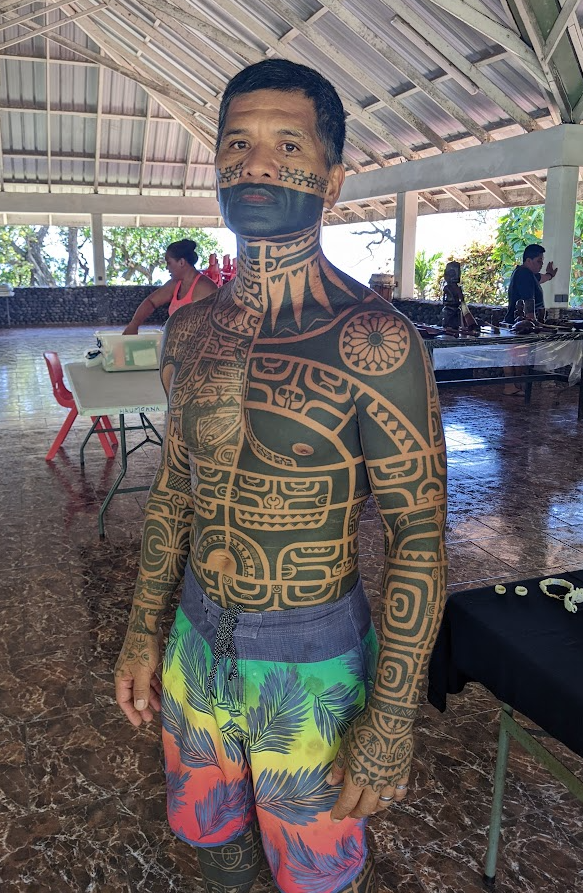
No, seriously, he was very nice, spoke way better English than I speak French or Marquesan, and had some incredible carvings. I did buy one from him, an exceptional tiki necklace, the smaller one in the picture below.
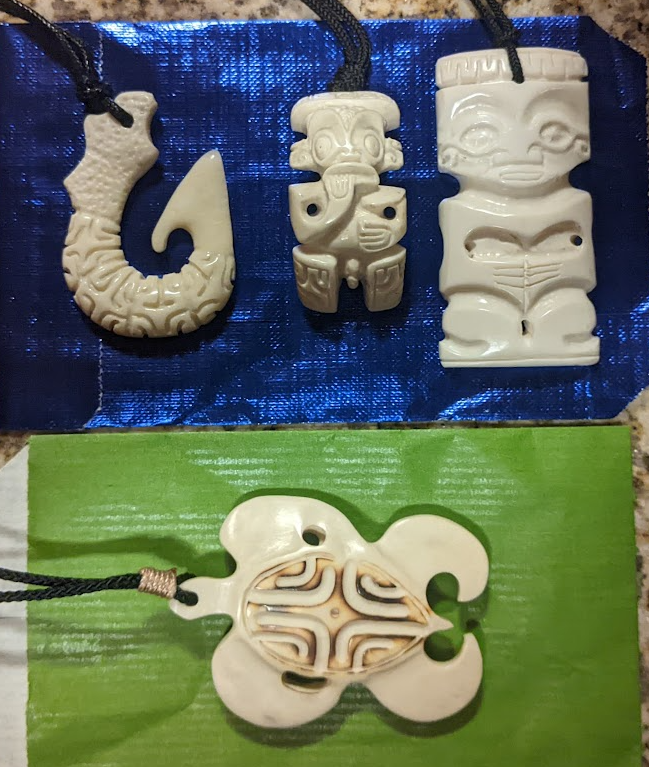
After Hapatoni, we visited the village of Vaitahu, where we had a fabulous lunch at Chez Jimmy, and got a good look at the beautiful Catholic church, made from all local stone and wood. We’ve seen larger, more impressive churches in Europe, but never one more perfectly suited to its environment. The story goes that the local people had only a small church, so they wrote the Vatican asking for money to build a nicer one: the money came, and this is what they built!
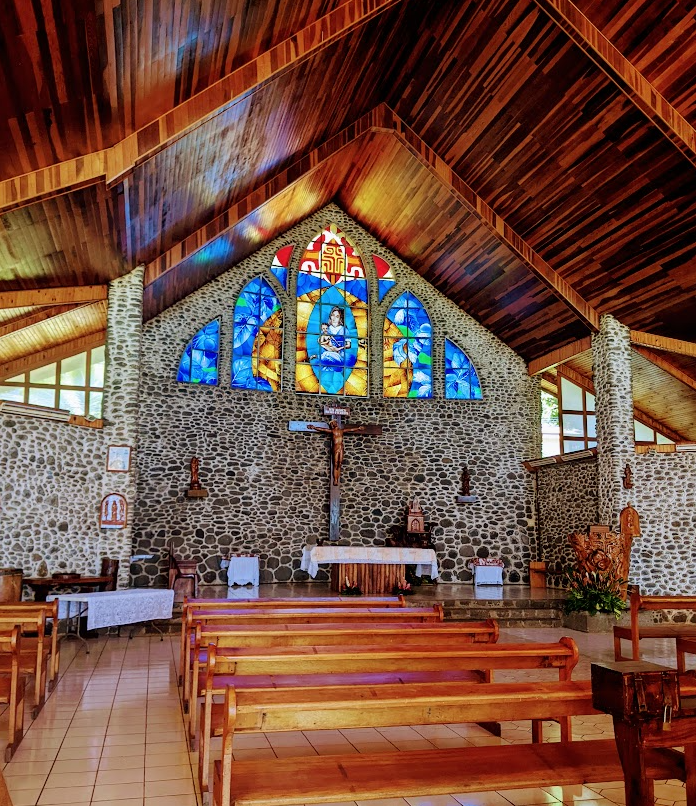
The last stop of the day was a secluded white sand beach with hundreds of coconut palms starting at the beach. We snorkeled a bit, and then Bly taught us how to cut a stout stick into a coconut husking tool, then husk the coconut, then crack it open, then remove the juicy white meat for snacking, then shred the husk so that he could, literally, rub one stick of wild hibiscus tree against another larger one, to start a fire in it. Finally, he taught us all how to weave the fronds of the coconut palm into wreaths to wear on our tourist heads, and little palm frond fish. By this time, Bly had earned a place on our All-Time Top Three Tour Guides Anywhere… and we couldn’t think of any two others who really deserved to be on the podium with him!
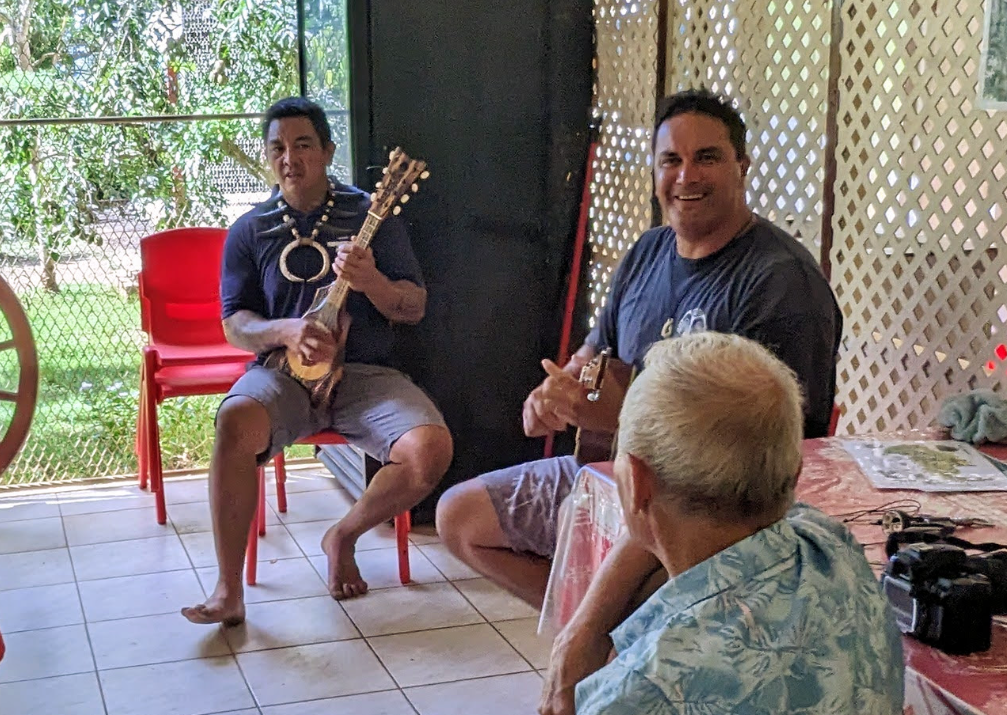
Fortunately for us, Day Two was also with Bly, this time on his home island of Hiva Oa. There was a lot of driving, because the main objective of the day was to see the most famous of the tikis on the island, and they are scattered far and wide. The road was surprisingly good 99% of the time, which is a good thing, because much of it ran right next to cliffs that, if we went over them, would turn our truck into a fiery ball of screaming, flaming tourists tumbling down to the sea. And while the road is as smooth as you could ask for, I could have asked for a lot more guardrails! But the tikis smiled on us (and Bly is an excellent driver), so we didn’t die.
Speaking of smiling tikis, there is a famous one on Hiva Oa, and it was our first stop. The vast majority of tikis seem to have no facial expression, other than “stern”, but this one is unquestionably grinning. No one knows why he’s grinning (I think it’s because he just got his new glasses and he can finally see!), but he’s the only one they know of who is.
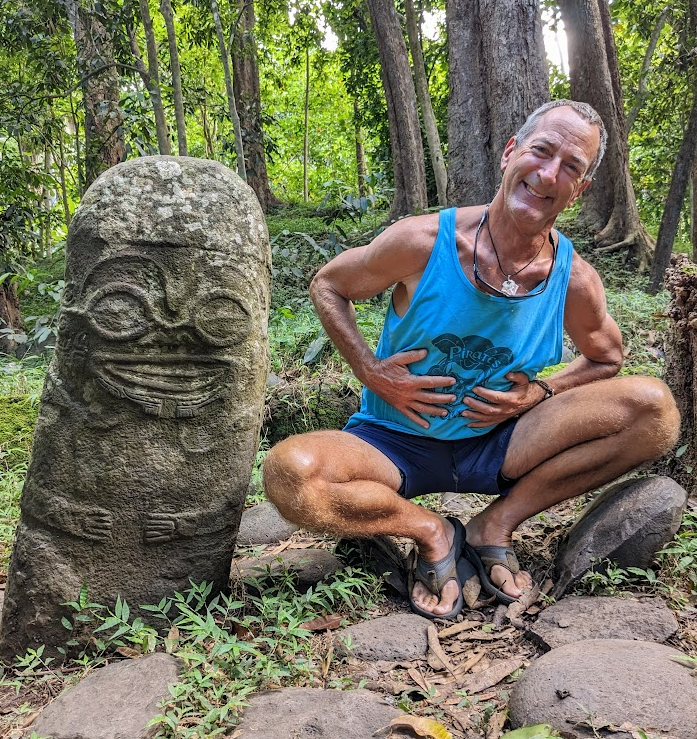
Our second stop was the village of Hanaiapa on the north side of the island, where we sat at the beach and learned about life in the Marquesas, from someone who has lived it, and continues to live it – the amazing Bly. As you might have guessed, Bly is short for Captain Bly, which is what he’s been called since he was a baby. When he was young, he literally thought his first name was Captain! But it’s not – it’s Bryan, and his last name is O’Connor! His great grandfather came from Ireland to French Polynesia and married a Polynesian woman. They had a son who married a Polynesian woman, and then they had a son who married a Polynesian woman, and then they had a son and named him Bryan. How fun is that!
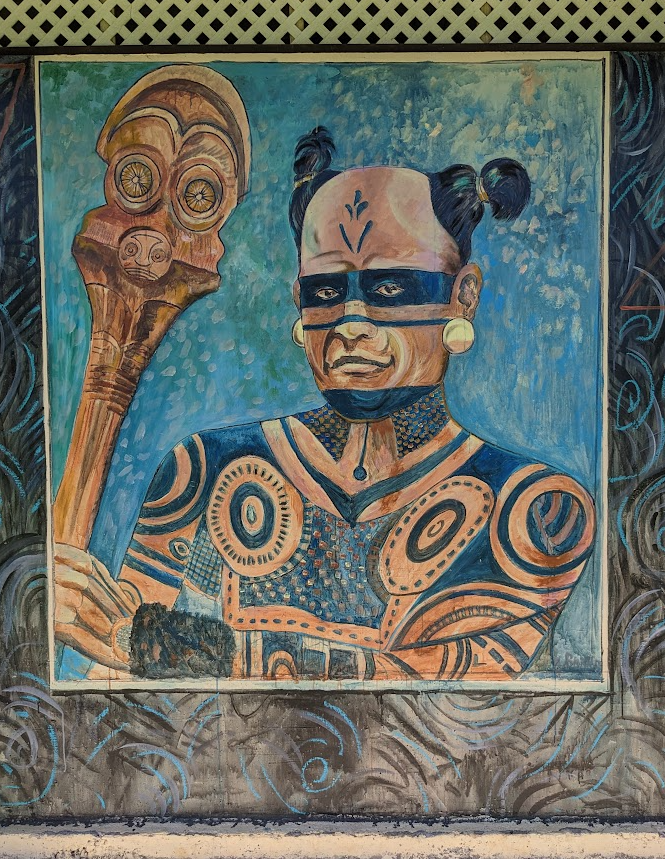
Bly (that’s what everyone still calls him) went to university in Hawaii and was there for three or four years, where he learned to speak excellent English. But he came back to Hiva Oa and, like all of his recent paternal ancestors, married a Polynesian woman (she’s from Nuku Hiva, about 100 miles away). They have six children, including a 1 1/2 month old boy named – you guessed it – Bryan O’Connor. 🙂 But the full names of all of his children are amazing Marquesan names, so be sure to play the video link below. Now he’s a local tour guide who carries on the Marquesan traditions with his family, and shares them with lucky visitors. If you ever happen to be on Hiva Oa, you Oa it to yourself to spend a day or two with him!
Click here to see Bly recite his children’s amazing names.
After learning about the family history of the Marquesan O’Connors, we drove from Hanaiapa for 45 minutes or so to Puama’a, the site of several tikis, including the largest one in all of French Polynesia*, and the only known tiki to be oriented horizontally (like a turtle). The tikis are scattered around a site that includes a lot of stone walls and platforms, which were common in Polynesian, and especially Marquesan, culture. Unfortunately, we don’t know very much about the tikis or the platforms or the culture in general because white men from Europe pretty much obliterated the people and their culture. An estimated population of 80,000 native people in what is now called French Polynesia shrank to about 2,000 by 1925, due to diseases introduced by Europeans and weapons wielded by Europeans. Because Polynesians had no written language, this decimation of the population also resulted in the loss of the vast majority of their stories – their history. And of course the Christian missionaries did all they could to stop the practice of so many of their traditions – carving tikis (“false idols”), tattooing themselves, building stone structures that weren’t Christian churches, etc. Way to go, white folks!
(* Largest of all the ancient tikis – of course there are larger ones created in modern times.)
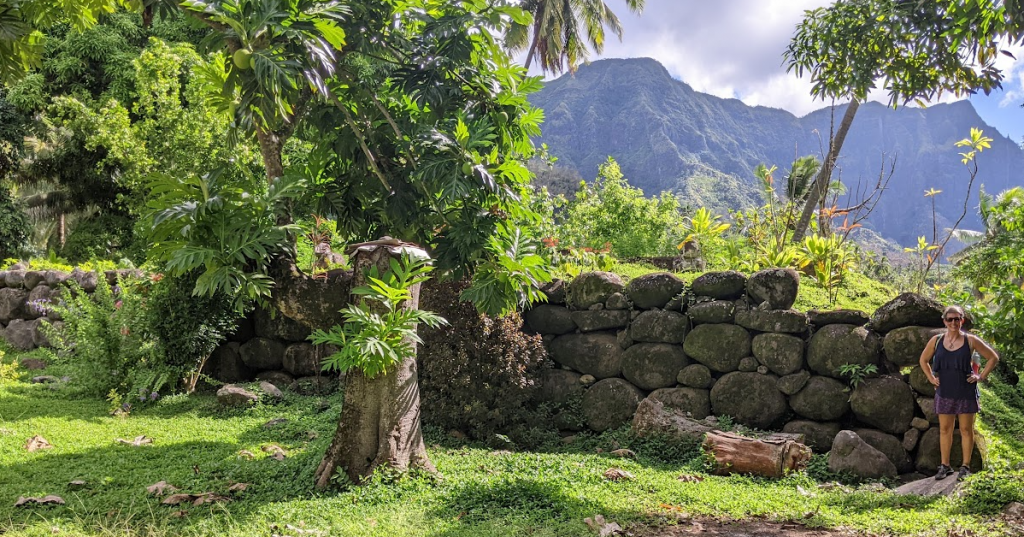
At some point during the day we stopped for lunch at Cafe Marie Antoinette, where we were treated to several local favorites: poisson cru au lait de coco (raw fish with coconut milk, which had already become a favorite of ours by that time in this trip), goat in coconut milk (it was cooked), wild boar (also cooked), fried tapioca root (a.k.a. cassava), and a couple of very sweet, very delicious desserts made with bananas, tapioca, and coconut. While enjoying lunch, Bly and his cousin Harry (we never got Harry’s story, sadly) serenaded us with ukelele and song, and then had us all do a sing-along that you can experience on one of the videos in the Google Photos library linked at the end of this post.
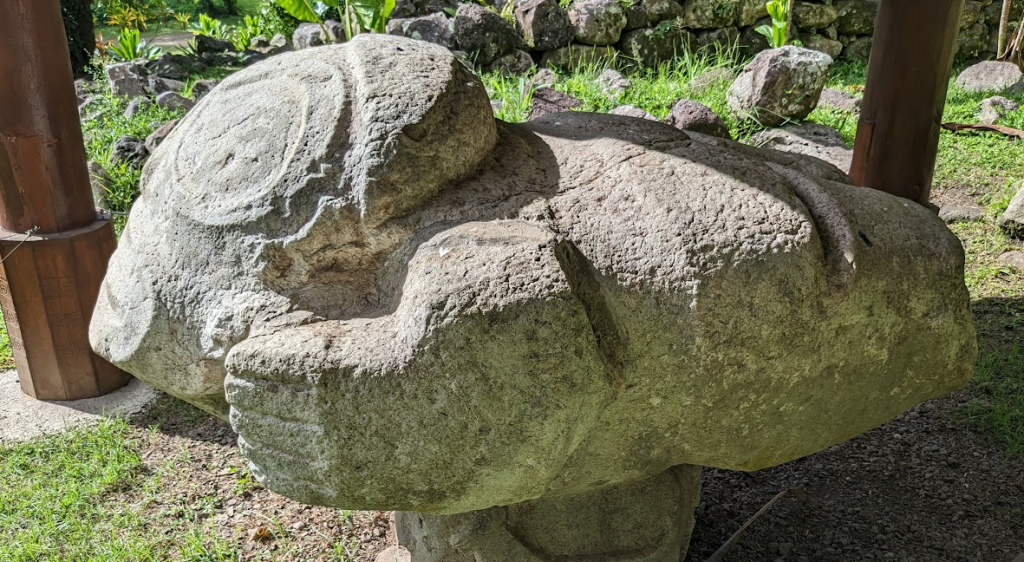
At another stop along the way – your typical roadside “scenic viewpoint” – Fran spotted something in the water about 500 feet below us (not joking), which turned out to be eight manta rays cruising around the bay. That brings to ten the number of manta rays we’ve seen on this trip, none of them very satisfactory. I mean, it’s cool to see them, even from 500 feet up, or cruising past or under you in a dive – but we want to experience them! That’s still possible: there’s a place called Maupiti…
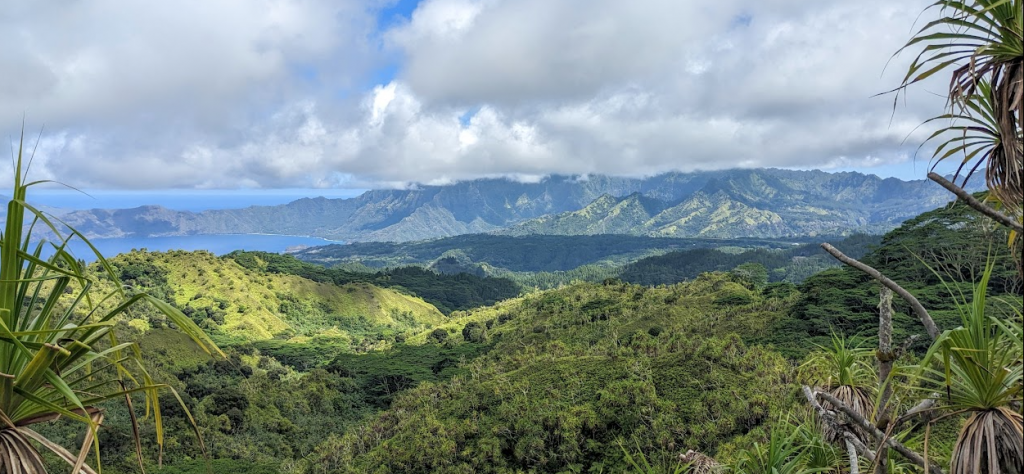
Wow, what a couple of days! But before I forget, I need to try to convey how incredibly beautiful the island of Hiva Oa is. You can get a small taste of it in the pictures in this post and in the photo library at the end, but as with virtually all majestic views, the pictures don’t do it justice. The peaks are so big and spiky and dramatic, often covered in clouds, or backlit by the rising or setting sun. The ocean crashes right into the feet of the mountains in so many places, which may explain why the ocean seems so big here! (I know – the ocean is big everywhere – but it seems bigger here.) The valleys are so green, the villages so colorful, the trees and flowers so gorgeous. It’s no wonder Gauguin fell in love with the place. So, too, did a very famous Belgian singer / songwriter / actor, Jacques Brel. He and his wife spent a good deal of time here during the final years of his life, and he’s buried here, not far from Gauguin’s grave. If you ever plan a trip to French Polynesia, you need to include Hiva Oa!
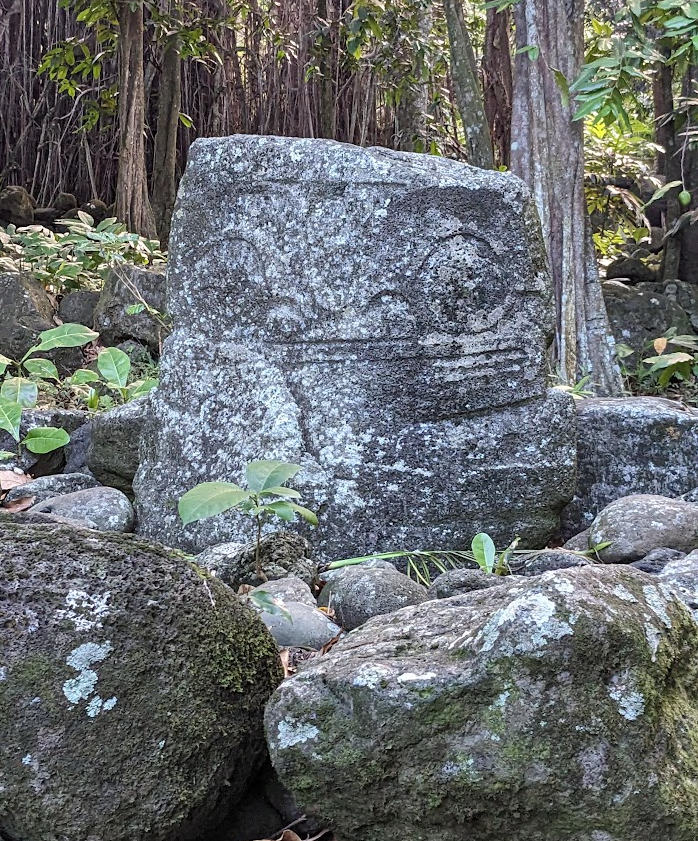
Days Three and Four were spent leisurely driving around the island in our trusty rented Suzuki Jimmy 4×4. It’s like a miniature version of the original Ford Bronco. We needed it to get up the hill to our bungalow, though! (There’s a video of that, too.) We visited another ancient village with stone structures scattered over an area of a couple of acres, with just one remaining tiki. We drove to the beach to watch the locals enjoying their Sunday. (They play a game here called petanque that is, as far as I can tell, just like bocce, and they play seriously!) And we soaked up the wonderful vibe of the island, and of our very special home away from home there, Villa Enata. I can’t imagine returning to Hiva Oa and not staying with Mimi and Pierric again!
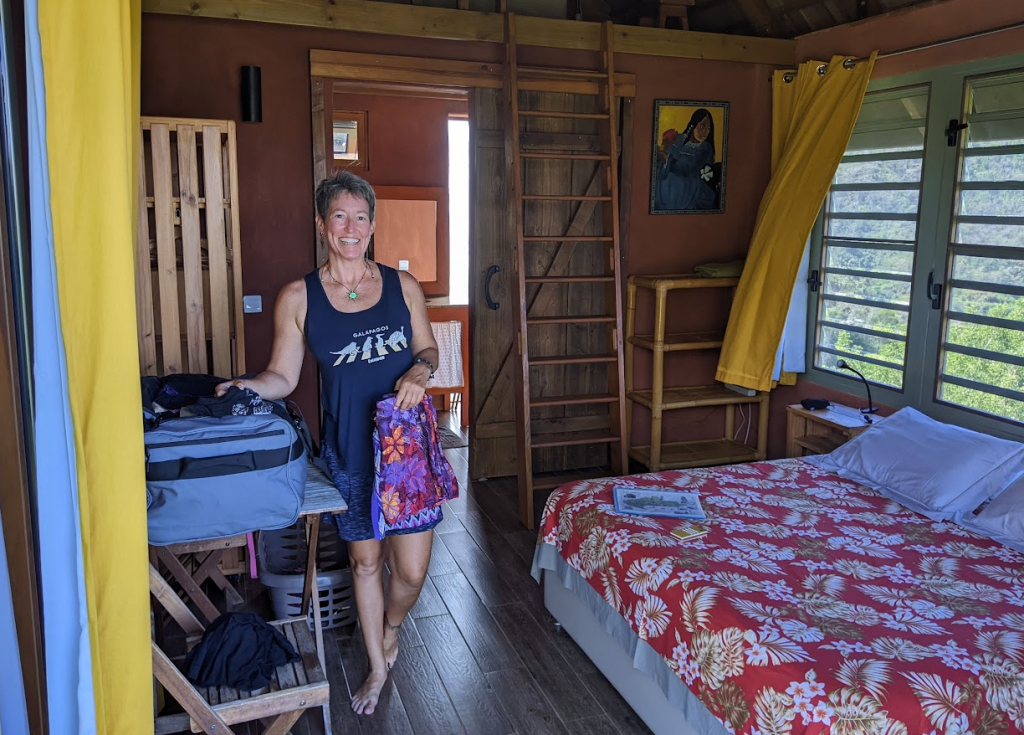
Fun Fact: the time zone of the Marquesas is 30 minutes ahead of the time zone of Tahiti! Not sure why – time here doesn’t seem all that important, so it seems it would have been simpler to stay on Tahiti time. But they didn’t, and maybe that says something about how Marquesans feel about being Marquesans. I love it!
Click here to view our Google Photos library from Hiva Oa.
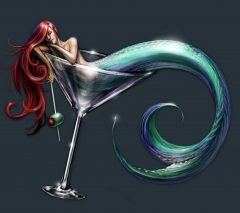
Looking at the picture of Butch and the Tiki I can see where the idea of the Minion’s originated. Hopefully soon after your return there will be a trivia category on French Polynesia so you (WE) can dominate! Miss you two and look forward to your safe return.
He does look like a Minion! (I don’t, of course.) See you in July, Tad!
My first thought was… MINION
One heckuva trip Brian
a tour de force of a report
thanks
Thanks, Bill! Glad you liked it.